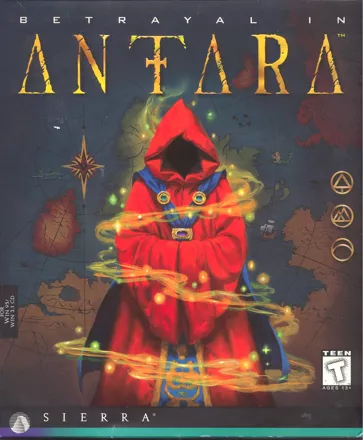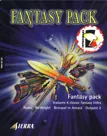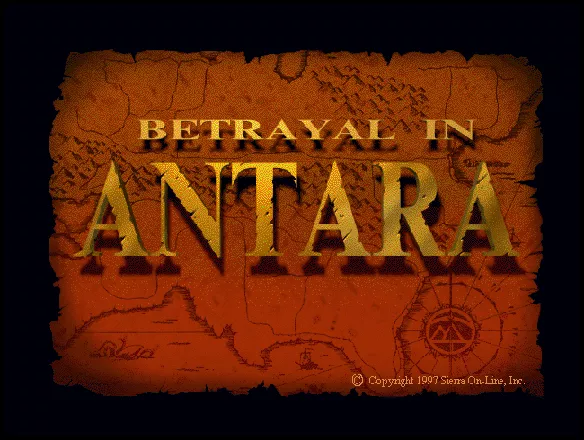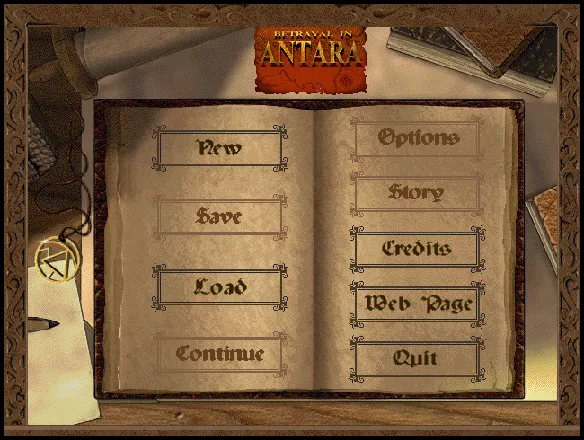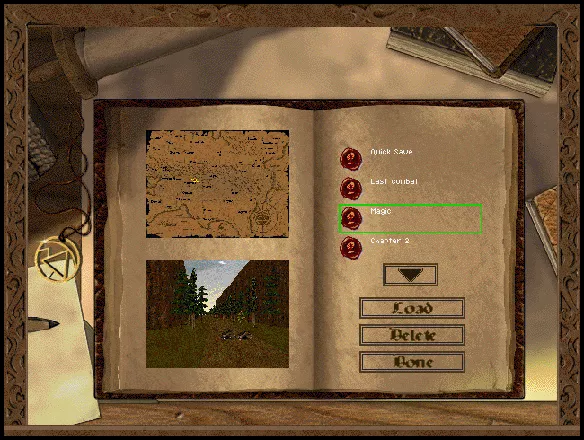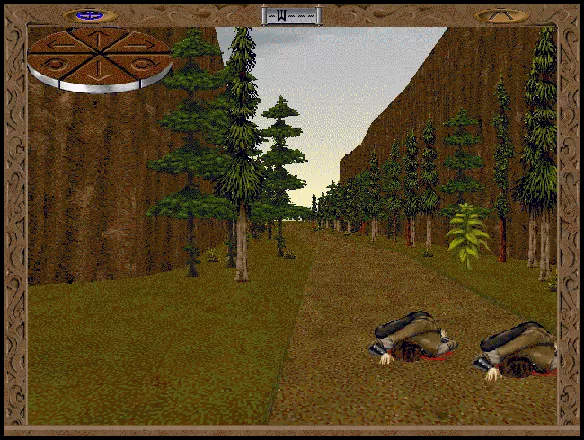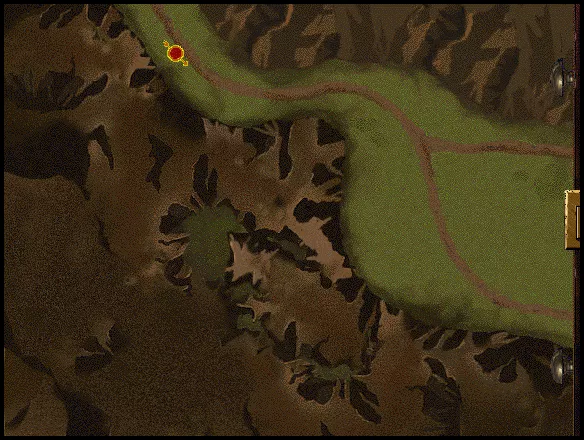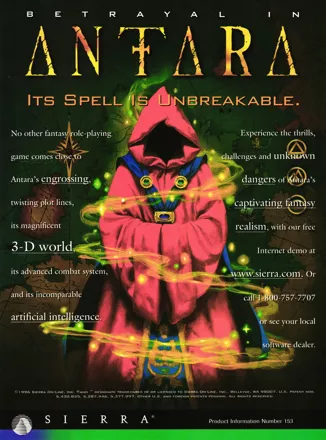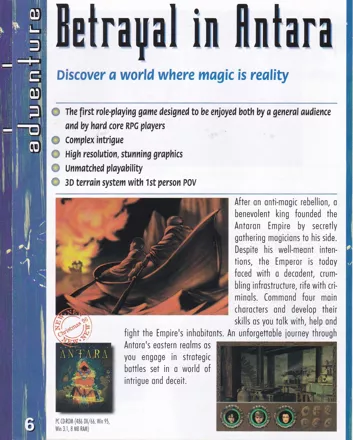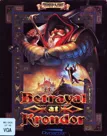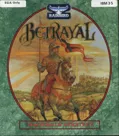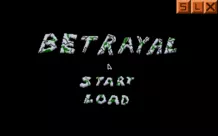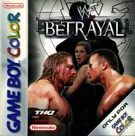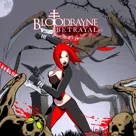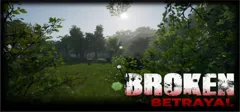Betrayal in Antara
Description official descriptions
Betrayal in Antara uses an updated version of the game engine from Betrayal at Krondor. However, it does not continue Raymond E. Feist's Riftwar saga, but instead starts a new tale set in a different fantasy world, known as Ramar.
The story begins with William Escobar, the son of the governor of Pianda, sailing home to meet his fiancee. The ship is attacked by pirates, and William escapes in a life boat with a mortally wounded traveler. Before he dies, the stranger gives William a medallion, warning him of a conspiracy against the Empire. William meets a young magician named Aren, who has just discovered devastating powers within himself, and the two decide to meet William's father and ask for his advice concerning the unsettling information.
The game plays very similarly to Betrayal at Krondor. The player navigates a party of three characters through the 3D world - this time with an optional full screen view. Enemy encounters occur at set positions on the overworld or within the few dungeons. An encounter triggers a separate battle screen, on which player-controlled party and the enemies engage in tactical turn-based combat. It is possible to sneak on enemies for a surprise attack if the character's corresponding skill is high enough. Unlike the predecessor, most towns can be physically explored, though a few are still displayed as a map with icons representing locations. Indoor environments and characters, however, are presented as hand-drawn images.
Like in Betrayal at Krondor, characters join and leave the party as dictated by the plot. Aren is the only character who can cast spells, while others act like fighters or rangers. Magic elements can be researched and mixed to create spells, and include a wide array of protective and offensive magic. The skill system is very similar to that of the previous game: skills are improved by repeatedly using them and marking them in the skill menu for faster learning. Elements like a day and night cycle, weapon and armor repairing, navigation on world map, the necessity to eat and sleep regularly, etc. are also brought over from the earlier Dynamix game. Although the game is somewhat more linear, there is still a large amount of side quests taken from NPCs populating the game's many towns.
Spellings
- 叛變安塔拉 - Chinese spelling (traditional)
Groups +
Screenshots
Promos
Credits (Windows version)
94 People (76 developers, 18 thanks) · View all
| Design | |
| Lead Programmers | |
| Art Director | |
| Producer | |
| Programmers | |
| 3D Programmer/Team Systems | |
| Game Artists | |
| Graphic Novel Artist | |
| Design Assistance | |
| Team QA | |
| Music | |
| Dialogue | |
| Sound Effects | |
| Dialogue Writers / Voice Direction | |
| Systems Programmers | |
| 3D World Creators and Editors | |
| [ full credits ] | |
Reviews
Critics
Average score: 69% (based on 18 ratings)
Players
Average score: 3.4 out of 5 (based on 24 ratings with 2 reviews)
Weak in many departments; for RPG lovers, pays off in the end
The Good
The Basics: Betrayal in Antara is Sierra’s follow-up to Betrayal at Krondor, a critically acclaimed RPG based on Raymond E Feist’s Riftwar saga. Antara takes the mechanics from Krondor and scraps the world (the rights of which were given to another developer), instead setting the game in the Empire of (surprise) Antara in the world of Ramar.
Graphics
The game doesn’t make a good impression graphically from the word go. The game is limited to 640x480 resolution in 256 colors, outdated at the time of release, but this isn’t really what hurt it. Games that looked great in 640x480x256 that come to mind are Diablo, Diablo II and Age of Empires. Antara’s graphics seem more like they were automatically compressed down to this level, instead of designed for it, however; the palette limitation really shows.
The rendering engine is extremely dated. It’s some kind of a poorly executed software rasterizer; your vision is limited to looking straight ahead; 3d surfaces, which are very rare, are simplistic enough to fit in the game’s ’93 predecessor, and most decals in the gameworld such as trees and signs are very low-detail 2d sprites. Altogether, the game is just plain ugly. Also, in an ironic 180 from Krondor, where the field of view was weirdly stretched so that it seemed like you were turning 720 degrees just to make a complete revolution, Antara shows you far too much in the small display box, making a complete turn take about half as long as it seems like it should.
When you step inside a building or visit a large city, instead of letting the game’s engine handle it, the designers wisely opted for sticking with Krondor’s method of displaying 2d images of the area. This allows for a lot more detail and, on occasion, beauty than the world renderer could possibly handle, but it also suffers from the aforementioned palette limitations. Some of the scenes are nevertheless strikingly good.
Score: 3/5
Audio
The sound effects in Antara are well done. They’re nothing groundbreaking in their technical quality or artistic merit, but they’re always appropriate; the obligatory ‘swish’ for a failed attack, ‘zap’ for a lightning spell and grunts for death are all here and all well presented.
Antara’s music is good, the little of it that there is. You’ll only hear it in combat and inside certain buildings; there’s no theme, no standard, so it’s hardly as good as the music in RPGs such as Morrowind. But the little bit that we get to hear serves its purpose well as enjoyable ambiance.
The voice acting is where the audio fails. It’s bad. Very bad. The characters sound more like comedians mocking the poor quality of the dialogue than actors trying to do their best with it; the exception here being Kaelyn’s voice (but her speech still makes you wince because of the lines she’s given).
Score: 3/5
Single Player Gameplay/Balance
The storyline of the game isn’t too striking when it begins. A country boy named Aren dreams of adventure, a longboat from a sinking ship happens by where he’s fishing followed by a horrible beast which he destroys, he discovers he has magical powers, etc. etc. etc. We’ve heard it all before. But the game begins to gain depth as it goes along; although many of its facets are stereotypes (the unfairly discriminated beast-people, the much-loved evil organization called the ‘Shepherds’ that keeps them at bay, the mad wizard/scientist who inadvertently killed his wife and is the father of the lead female), they’re well presented enough to not bore the player too much between the more original parts, which, I might note, are actually quite well done.
The dialogue in the game is really bad. It’s humorous when it’s supposed to be serious and just painful when it’s supposed to be humorous (the jokes never get better than weak puns and awful double entendres). The narration is slightly better than the character dialogue, but not by far. Being an RPG, this really takes its toll on the game. When you can’t take any of the characters seriously, it’s damn hard to care about them.
As mentioned before, most of the mechanics of the game are straight from Betrayal at Krondor. You control up to three characters at once from a first-person perspective; each item has a piece of narration to describe it; weapons and armor wear down and can be repaired with the proper tools. Each character has an array of skills which improve over time and with use, faster if they’re selected to be trained at the time. Magic is researched by discovering different schools and selecting combinations of them to slowly discover new spells to cast. The basic game systems are quite well designed as they’re simple enough to attract neophyte gamers and (barely) intricate enough to keep veterans interested.
Combat is handled on a 2d hexagonal grid. Also right from Krondor, and still pretty cool, is that the grid imposes itself right where the combat began; you fight in the exact same game world you normally travel around in, instead of the game switching to some ambiguous area that looks sort of like it except it uses combat graphics. Combat mechanics are fairly simple: you shoot, hit or cast the bad guys to death, with some minor complications like enemies that resist a certain type of weapon. The biggest flaw in combat isn’t actually IN it—enemies you’re supposed to fight simply stand around statically, not moving, in the world, until you fight them. It’s pretty ridiculous.
Altogether, the mechanics make for an enjoyable, if a simplistic, RPG to play through; but the game doesn’t utilize them often enough. Some skills are grossly under balanced, and the side-quests involve carrying items around or killing a random group of creatures far too much. Nevertheless, the game manages to remain a solid and relatively enjoyable RPG experience all the way through despite its glaring flaws.
Score: 3/5
The Bad
Interface/Technology
I hate it when games get picky about the display resolution you run them in. It’s a royal pain having to switch to 16 bit color to play one game and then back to 32 bit for the next. It’s a whole different ball game, though, when a game demands to be played in 256 color mode when it’s been outdated for years.
That nasty flaw aside, the next bad thing is the graphics. The designers did not make use of the 256 colors they had available to them well. Even without palette swapping, 256 color games usually look better than this. It’s very poor design.
Then the game engine. As mentioned before, it looks pretty bad. Far too bad for a ’97 game. Since the engine has almost certainly been rewritten from scratch anyways (DOS to full Windows implies it), there’s no excuse for such a lousy renderer. It doesn’t even manage to look as good as, oh, Doom most of the time.
The game’s fairly stable; crashes are not unseen, but I’ve never had it do anything worse than a clean crash to desktop, and that’s pretty rare.
As far as the interface goes, it’s strictly mediocre. The game tab that displays character status and menu buttons automatically hides like the Windows taskbar, which is good design; the automap sections can be annotated with your own marks, and a Flashback feature lets you recall previous conversations with NPCs. That’s all good. The combat interface is less well done. You can’t specify to attack an enemy from a certain tile; you can only attack by taking the shortest possible route, and if you move to a tile next to an enemy you don’t automatically attack him. This gets really annoying by the late game. Skill management is a bit of a pain due to counterintuitive design. In conversations, topics to discuss appear which are often misleading.
Score: 2/5
The Bottom Line
If you don’t mind really bad graphics, can put up with the inane dialogue and liked Betrayal at Krondor, Antara is worth a try. I think that it’s worth playing through once, because the tolerance ultimately pays off; the late game especially is quite enjoyable and the ending satisfying. If you didn’t like Betrayal at Krondor, can’t deal with bad dialogue and voice acting or demand good graphics… don’t waste the time.
Score: 3/5
Windows · by ShadowShrike (261) · 2003
The Good
Antara tried to combine several interesting features into one game, unfortuantely the result was uneven gameplay.
Antara had likeable protagonists, a highly detailed story, and the world of Antara seemed believable. Most fantasy games don't have economic systems, political systems, or cultural/personal interaction. Just think of Diablo.
Antara's turn-based combat system worked well too.
The Bad
Antara was dialog heavy, which would have been fine except when characters "spoke," their picture was put up in the screen with their mouths half open. There was no character animation.
Antara had some interesting quests, but many of them were delived item A to point B.
Antara strived for realism. Your characters got hungry and tired. This was a good feature but poorly implemented. The first time I played the game my characters starved to death before I could get them to the first location.
Also, just meeting the minimum specs made for sluggish gameplay. This baby ate RAM.
The Bottom Line
Complex role-playing game that seeks to immerse the player into a complicated political structure. Poor gameplay and too much dialogue helped to hold this back
Windows 16-bit · by Terrence Bosky (5395) · 2001
Discussion
| Subject | By | Date |
|---|---|---|
| Mining? | Indra was here (20735) | Apr 8, 2010 |
Trivia
References
One of the characters is named Torrance Pasege. This refers to another Sierra game: Torin's Passage.
Analytics
Related Sites +
-
The Common Room
Betrayal in Antara message board
Identifiers +
Contribute
Are you familiar with this game? Help document and preserve this entry in video game history! If your contribution is approved, you will earn points and be credited as a contributor.
Contributors to this Entry
Game added by Tony Van.
Additional contributors: Terrence Bosky, Jeanne, Paulus18950, Duduzets, Patrick Bregger.
Game added January 8, 2000. Last modified November 18, 2024.


